Early man revered animals for their endurance, prowess and cunning. Fear and favor are the two dimensions of the human mind that consolidated respect for animals. Perhaps belief in the transmigration of souls also fostered respect for animals. Such an outlook has often transcended from respect to sanctity. On Goa’s cultural canvas, sacred animals find a distinct place.
Animals in Sacred Depictions
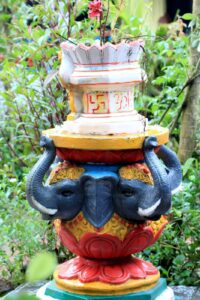
Tulsi vrindavans in the courtyards of houses in rural Goa are a perfect medium for the depiction of reverence to animals. The sanctified animals shown in concrete moulds are the cow, bull, horse, lion, elephant, crocodile, turtle, serpent and peafowl. Zoomorphic gargoyles are an integral part of temple architecture in Goa. Commonly in bovine shapes, these gargoyles are mounted on the outer walls of the garbha griha. Following abhisheka, the ceremonial ablution given to the deity, the water flows out through the gargoyles into the soil, ensuring that the holy water is not desecrated.
Temple interiors also include wood carvings on the pillars that depict mythological scenes. Many animals that are the vahan (or mounts of deities) in the mythology, figure here. Turtle shaped wooden receptacles called kurmasan are used for placing the sacred scriptures in many homes and places of worship.
Anthill worship
Impressed by the architectural marvel of the ant hill and the highly organized social order of its occupants, our ancestors worshipped the ant, a marvel of nature.
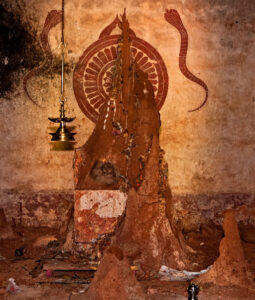
In many parts of Goa, anthills symbolize the deity Santeri. The etymology of the word could be an inspiration from the Sanskrit word santra for an anthill.
Sacred reptiles of Goa 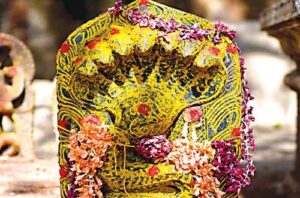
Jagyacho sorop – The resident serpent
Snakes rank second after the cow in Hindu mythology and are very popular totemic creatures. It is the movement, hypnotic eyes and the fatal bite of the snake that evoke fear and respect. In olden times, most of the homes had their own snake shrines in the backyard or gardens, where a lamp would be lit every evening to propitiate the reptile, locally known as jagyacho sorop (Konkani for guardian snake of the place).
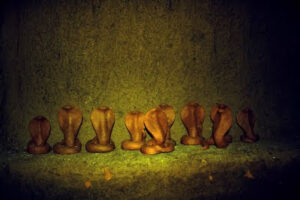
The household believed that frequent sighting of this snake would actually signal an impending disaster. On the occasion of Nag Panchami, young girls in Goa observe fast and give offerings of milk and corn for the well being of their brother. 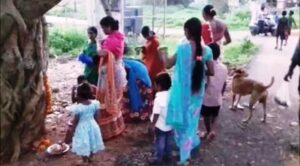
Manngem thapnee – Crocodile worship
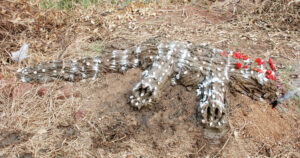
Among the primitive agrarian cultural expressions of Goa is the curious practice of manngem thapnee (Konkani for crocodile worship). This is a ritual performed by the Hindu Gawdas (ethnic tribe of Goa) who dwell in the hamlets of Bhoma and Durbhat wadi along the Cumbarjua canal, the natural habitat of the marsh crocodiles of Goa. On the new moon day of Paush month, the agrarian settlers assemble on the dykes of a waterlogged field, scoop silt from it and shape it in the form of a crocodile. The dummy is decorated with clam shells, flowers and vermillion. A fowl is sacrificed, followed by Garanhe (Konkani for community prayer) for a good crop yield. This pagan ritual has got ingrained in the local community for ages and is being followed with unshakable devotion. The practice takes its roots in the belief that appeasing the rain God Varun Dev by worshiping its mount, the crocodile granted protection against inundation of paddy fields following a heavy downpour.
Kak daan – Offerings to the ubiquitous crow
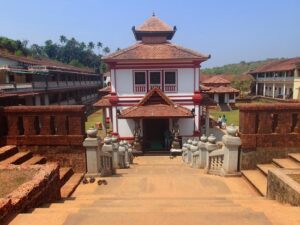
The crow is venerated and given kak daan, offerings of rice in the precincts of the Mallikarjun temple in Gavdongari. Also, on the demise of a Hindu, the kin have to perform rituals for the deliverance of the departed from the cycle of life and death. On the twelfth day after the death of a person, pind daan is performed and the acceptance of the worldly offerings by the soul is indicated by the crow pecking at the ball of rice called the pind.

Sacred mammals
The horse is associated with the Devchar or the guardian spirit. The faithful give offerings of terracotta horses under the trees of the guardian spirit in reciprocation of fulfilled desires.
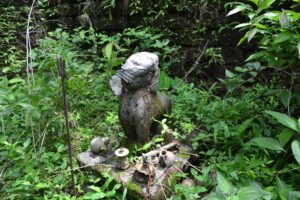
The Velips, a tribal community of the hilly region of Canacona, honor the faithful dog by worship. At Ganv Dongari, a hamlet dominated by this community adjacent to the temple of Bhumi Purush, a stone replica of a dog called Soonnya dhupem, estimated to be over 500 years old, is an object of much awe. In a ritual called wadi, this religious symbol is worshipped thrice a year on the occasion of Ashadi poonav, Shimmya poonav and Suta poonav.
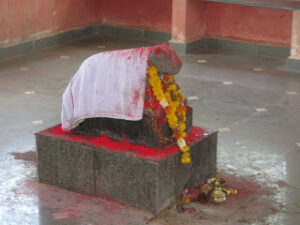
Wilds cats also find a place in Goa’s eco-theology. In an obsolete cave at Narve called Pandavanchi hovar is a lion icon worshipped by the locals. Also, the Vagro dev (tiger deity) is popular in Bicholim and Pernem.
Source
http://goastreets.com/spot-a-crocodile-in-goa/
https://theflightofgods.wordpress.com/tag/tribal-shrines-of-goa/
http://blog.parrikar.com/2011/01/03/the-sacred-anthill/
http://goacom.com/revering-snake-worshipping-nature/
http://goawildwatch.blogspot.in/2011/08/nagpanchami-and-snake-bite-protocol.html
http://fullproofgoa.blogspot.in/2011/07/tiger-worship-in-goa.html
https://hiveminer.com/Tags/northgoa,tourism/Interesting
http://ecofriendlyindianhome.blogspot.in/2012/10/lovely-elements-of-exterior-decor-goa.html


